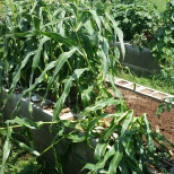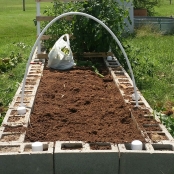How to Grow Sweet Corn in a Raised Garden Bed
Our raised beds have us re-thinking planting schemes for the various veggies that we grow. In order to pollinate, Corn, for example, is grown in rows (in-ground) with each plant spaced about 6 inches apart and each row about 18 inches apart. Due to space limitations in a raised garden bed, those dimensions need to be adjusted just a bit.
A good planting scheme resource to use with raised bed gardens is the book; Square Foot Gardening, by Mel Bartholomew (there’s a second edition out). So, we are testing the recommended planting schemes to learn more about how they work in our beds. One of those veggies tested was sweet corn.
The book recommends planting 4 corn plants per square foot. We set up a garden scheme of 2 feet wide by 8 feet long — a total of 16 square feet of garden space — and planted 4 seeds per square. The variety is “Bodacious”.
Sweet Corn Results
Observations:
- about 75% of the potential number of kernels was produced (no pollination in the upper 25 to 30% of the cob).
- Just over 16 cups of shucked corn produced (about 1 cup per square foot, or each 4 plants)
Inferences/Conclusions:
- pollination was good (plants thick enough), but reducing the number of plants per square foot may increase yield if the plant has more space to add photosynthesizing leaf surface
- Yield may increase with more space per plant; try 3 plants per square foot
- Rather than drawing the squares side by side, add 6 to 12 inches of space between the two “rows”.
Growing and Harvesting the Sweet Corn
- Four seeds were planted per square foot, along the 8 feet; seeds were equally spaced along the edges of the square (2 seeds per linear foot, all equally spaced along the 8 feet). This was repeated for the opposite edge of the square.
- Seeds were watered, a light layer of shredded bark mulch was added, and watered until about 1 inch of water was added over the top.
- As plants sprouted, empty spots were re-seeded. (About 97% germination rate for the first time, 100% within 10 days).
- We watered for about two weeks (about 1 inch of water over the soil), then the rains started and we watered only when the bed dried out (about twice in May).
- The ears were allowed to develop about 3 to 4 weeks.
- Ears were pulled from the stalks, and stalks were removed for the compost pile. NOTE — very easy process, we pulled these up from the heavy organic matter soil and the soil was raked with a long hand tool rake. The process was completed within an hour.
The Harvesting Process in Pictures.
We will be trying a lower density of corn — same variety — to find out if we can increase the yield. Stay Tuned!








